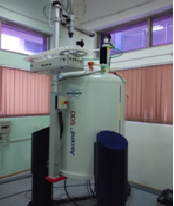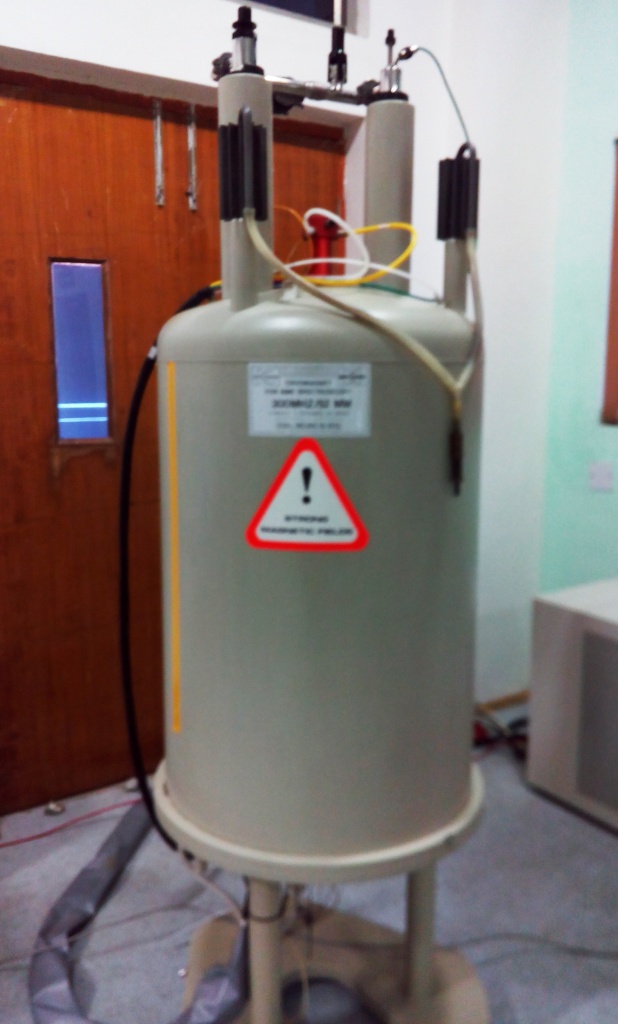Overview
Nuclear magnetic resonance spectroscopy (NMR) has become the pre-eminent technique for determining the structure of organic compounds in the various stages of drug development, Bio-macro molecules and metabonomics. Of all the spectroscopic methods, it is the only one for which a complete analysis and interpretation of the entire spectrum is normally expected.
NMR facility in CDRI is unique and is highly regarded for its versatility in the types of samples we can work on e.g. organic molecules, APIs, metabonomics, peptides, peptidomimetics, proteins and other bio-macromolecules and as well as the number of nuclei that can be studied by solution and semi solid NMR. The facility has a total of
Six high-field NMR spectrometers ranging from 300 MHz to 700 MHz with a range of capabilities: high sensitivity cold probes for bio-molecular studies, high throughput sample changers for small molecule analysis, HR-MAS probes for small columes and semi-solid samples. Highlights of this facility are two advanced high-resolution NMR systems,
700 MHz Agilent (Varian) with DD-2 technology, high sensitivity cold probe and 500 MHz Bruker Avance-III spectrometers.
Capabilities, expertise and services offered
We offer advance NMR expertise for national and international collaborations and support for industrial, government or academic research. NMR has diverse multidisciplinary applications
ranging from quantitative NMR, raw material screening, lipid profiling, natural product structure elucidation, metabonomics, and semi-solid capabilities. Applications include, whether
your research involves to determine high resolution three dimensional structures of important biological macro-molecules at atomic resolution in solution or study biomolecular motions
that are important for understanding their functions or characterize protein-protein, protein-DNA and protein-small molecule interactions or evaluate a newly synthesized small-molecule
and isolated natural products or unravel underlying mechanism of biological function from molecular to atomic level then you have come to the right place. Please take some time to
explore our facility and get to know the services that we currently offer. Should you looking for an application that is not listed in our web site please do not hesitate to discuss
with us. We are here to facilitate your research and enhance your knowledge about diverse applications of NMR.
The table (Click here to see table) below will assist you to select the right instrumentation and right experiment. Apart from technical support our
facility
will also provide training for those who are interested to receive training on the high-field NMR spectrometers and the training courses may be framed based on the individual needs.
Our services can be broadly classified as follows:
|
•
Structure Elucidation of small molecules
|
•
Reaction Kinetics
|
•
High resolution 3D-structure of bio-macro molecules
|
|
|
|
|
|
• Protein-ligand interactions (STD techniques etc.,)
|
• Quantitative NMR
|
• Metabonomic Profiling
|
|
|
|
|
|
• Protein-ligand interactions (STD techniques etc.,)
|
• Training on High field NMR spectrometers
|
|
Major Equipment and Instrumentation
|
|
➤
Bruker Av III HD 500 MHz*
Equipped with 5mm-Triple resonance probe with ATM, and a 120 auto sampler. Capable of performing all experiments related to the structural elucidation of small and intermediate size molecules and Proteins. Suitable to perform metabonomic studies. VT range from -150oC to +150oC
|
|

|
| |
|
➤
Bruker Av III HD 400 MHz*
Equipped with 5mm-BBFO probe with ATM and 120 auto sampler. Capable for observing 19F with 1H decoupling and also capable of observing any nucleus in the range of 31P to 15N. VT range from -150oC to +150oC
*Capable of performing all experiments related to the structural elucidation of small molecules.
|

|
|
|
➤
Bruker Av III HD (DRX) 300 MHz
Equipped with direct detection probe, with capabilities to detect nuclei .
*Capable of performing all experiments related to the structural elucidation of small molecules.
|

|
Charges & Sample requirement
Charges & Sample requirement
Application Form
Biological Assays Available
Expertise & Personnel
Instruments & Experiments
|
|
Bruker Av-III HD 500 MHz
|
Bruker Av-III HD 400 MHz
|
Bruker Av-III HD (DRX) 300 MHz
|
|
Variable Temperature
|
Possible
|
Possible
|
Not Possible
|
|
Proton Experiments
|
|
1D proton
|
✔
|
✔
|
✔
|
|
COSY, DQ-COSY, E-cosy
|
✔
|
✔
|
✔
|
|
J-Resolved
|
✔
|
✔
|
✔
|
|
2D NOESY
|
✔
|
✔
|
✔
|
|
2D ROESY
|
✔
|
✔
|
✔
|
|
1D selective NOESY, TOCSY
|
✔
|
✔
|
|
|
2D TOCSY
|
✔
|
✔
|
✔
|
|
Homonuclear decoupling
|
✔
|
✔
|
✔
|
|
1H T1 measurement
|
✔
|
✔
|
✔
|
|
STD (ligand binding)
|
✔
|
|
|
|
water suppression (PURGE)
|
✔
|
|
|
|
CARBON-PROTON 2D
|
|
|
|
|
HSQC
|
✔
|
✔
|
✔
|
|
HSQC-TOCSY
|
✔
|
✔
|
|
|
HMBC
|
✔
|
✔
|
✔
|
|
X-X or X-PROTON 2D
|
|
|
|
|
15N-1H HMBC
|
✔
|
|
|
|
15N-1H HSQC /w H2O supression
|
✔
|
|
|
|
31P-1H HMQC
|
|
✔
|
|
|
29Si-1H HMQC
|
|
✔
|
|
|
31P-31P COSY
|
|
✔
|
|
|
19F-13C HMQC
|
|
✔
|
|
|
|
|
|
|
|
X-NUCLEI 1D
|
|
|
|
|
13C
|
✔
|
✔
|
✔
|
|
13C /W 19F Decoupling
|
✔
|
✔
|
|
|
DEPT
|
✔
|
✔
|
✔
|
|
1H, 13C, 15N Multi-dimensional experiments
|
✔
|
|
|
|
H-H connectivity -through J coupling
|
|
|
H-H
Homonuclear decoupling
|
|
|
Selective excitation NOE, ROE, COSY etc.,
|
|
|
H-H spatial proximity
|
- NOESY (for macro molecules) 500
- NOESY (for small molecules) 500, 400
- ROESY (for intermediate M.W.) 500, 400
|
|
Carbon-proton connectivity through J-coupling
|
- HSQC or HMQC (Indirect detection) – one bond correlation
– 500, 400, 300
- HMBC (ID detection) – Long range 2 to 3 bond –500, 400, 300
- HSQC-TOCSY –500, 400
|
|
Heteronuclear 1D and 2D
|
|
|
1H, 13C/15N multi Dimensional
|
|
|
Water suppression
|
|